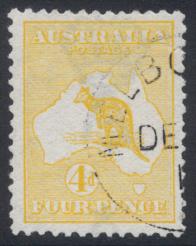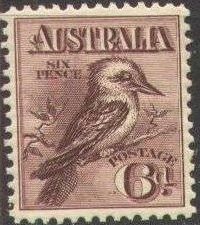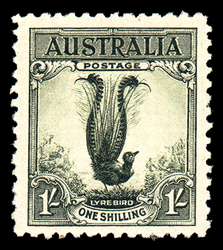


Return To Catalogue -
Australia miscellaneous - Australia Railway stamps
New South Wales - Queensland
- South Australia - Tasmania
- Victoria - Western
Australia - Western Australia
miscellaneous - North West Pacific
Islands - Australia Parcel stamps
Currency: 12 pence = 1 Shilling;
20 Shillings = 1 Pound
Capital: Canberra
Note: on my website many of the
pictures can not be seen! They are of course present in the cd's;
contact me if you want to purchase them: evert@klaseboer.com.
The former colonies New South Wales, Queensland, Southern Australia, Tasmania, Victoria and Western Australia were declared as commonwealth in 1901.
'ONE PENNY' (red) on 2 p violet (Tasmania) 'ONE PENNY' (red) on 2 p violet (Victoria) 'ONE PENNY' on 2 p yellow (Western Australia)
These three stamps were actually the first stamps to be valid in the whole of Australia.
Value of the stamps |
|||
vc = very common c = common * = not so common ** = uncommon |
*** = very uncommon R = rare RR = very rare RRR = extremely rare |
||
| Value | Unused | Used | Remarks |
| 1 p on 2 p violet (Tasmania) | c | c | |
| 1 p on 2 p violet (Victoria) | c | c | |
| 1 p on 2 p yellow (Western Australia) | c | c | |
1/2 p green 1 p red 2 p grey 2 1/2 p blue 3 p olive 4 p orange 5 p brown 6 p blue 6 p brown 9 p lilac 1 Sh green 2 Sh brown 5 Sh yellow and grey 10 Sh red and grey 1 Pound blue and brown 1 Pound grey 2 Pounds red and black

'Crown A' watermark on a 5 Sh stamp
For the specialist; these stamps were first issued with watermark 'Crown A' (specialists even distinghuish three kinds of this watermark). In 1929 these stamps were also issued with watermark 'Multiple Crown A' and in 1931 with watermark 'Multiple Crown C of A'. Most of these stamps were issued with perforation 12, though the later ones also exist with perforation 11 1/2.
These stamps were sometimes sold overprinted 'SPECIMEN' (see images). Stamps with round holes in it were used telegraphically (rare, since they were usually destroyed by the postal authorities), example:


(Telegraphic cancel: large hole)
Value of the stamps |
|||
vc = very common c = common * = not so common ** = uncommon |
*** = very uncommon R = rare RR = very rare RRR = extremely rare |
||
| Value | Unused | Used | Remarks |
| Watermark 'Crown A' | |||
| 1/2 p | c | vc | |
| 1 p | c | vc | |
| 2 p | c | vc | |
| 2 1/2 p | * | c | |
| 3 p | * | c | |
| 4 p | * | * | |
| 5 p | * | * | |
| 6 p blue | * | c | |
| 6 p brown | * | c | issued 1924 |
| 9 p | * | * | |
| 1 Sh | * | c | |
| 2 Sh | ** | c | |
| 5 Sh | *** | * | |
| 10 Sh | *** | ** | |
| 1 Pound blue and brown | R | R | |
| 1 Pound grey | *** | *** | issued 1924 |
| 2 Pounds | RR | RR | |
| Watermark 'Multiple Crown A' | |||
| 6 p brown | * | c | |
| 9 p | * | c | |
| 1 Sh | * | c | |
| 2 Sh | * | c | |
| 5 Sh | ** | * | |
| 10 Sh | *** | ** | |
| 2 Pounds | R | R | |
Watermark 'Multiple Crown C of A' |
|||
| 6 p brown | * | c | |
| 9 p | * | c | |
| 5 Sh | ** | * | |
| 10 Sh | *** | ** | |

Cancelled to order stamp? I've seen many stamps with a neatly
applied 'MELBOURNE DE 3 13' cancel (usually applied in a corner)
Forgeries: Sperati made forgeries of the 2 Pounds Kangaroo stamp. This Sperati forgery is printed on genuine paper by removing the design of a cheaper value. Therefore the cancels are also genuine. Example of such a forgery:


Sperati forgeries 'proofs', images obtained froma Shreves auction
If I'm well informed there should be a white flaw off Warrnambool (where this city is located on the map in Victoria). Sperati bleached out the design of a genuine low valued stamp and printed the new high value using photolithography. Also note that there is a dent in the upper right hand side of the '2'. Sperati forgeries are rare.

(Imperforate Hialeah forgeries, reduced sizes)
There exist some 'Hialeah forgeries' of the 2 Sh, 5 Sh, 10 Sh, both the 1 Pound values and the 2 Pounds value. I haven't seen them personally, but I suspect they were made with a scanner and printer. The quality of these Hialeah forgeries is quite bad, most of the smaller details are lost. These forgeries were offered in whole sheets in imperforate condition.
I've seen a souvenir sheet with the 1 Pound blue and brown and 2 Pounds Kangaroo stamps, together with a 1932 5 Sh bridge stamp printed for the Anpex 1972 exhibition. The cancels read 'ADELAIDE 22-27 AUG. 1927 SOUTH AUSTRALIA' and 'CENTENARY OF THE OVERLAND TELEGRAPH 1872-1972' (both in a single circle). The paper is intentionally different, as well as the sizes of the stamps (slightly smaller) and the perforation.

The Anpex 1972 souvenir sheet
Examples from this souvenir sheet:


(Individual stamps of the 1 Pound and 2 Pounds values from the
Anpex 1972 souvenir sheets)
1/2 p green 1/2 p orange 1 p red 1 p violet 1 p green 1 1/2 p brown 1 1/2 p light blue 1 1/2 p red 2 p orange 2 p red 2 p brown 3 p blue 4 p yellow 4 p orange 4 p violet 4 p blue 4 p olive 4 1/2 p violet 5 p brown 1 Sh 4 p blue Surcharged (1930) 'TWO PENCE' on 1 1/2 p red 'FIVE PENCE' on 4 1/2 p violet
For the specialist; these stamps were issued without watermark (1 p red, 1 p green and 1 1/2 p red only), also with watermark 'Crown A', 'Multiple Crown A' (only several crowns and 'A's) and 'Multiple Small Crown A' (with many small crowns and 'A's). In 1931 the watermark 'Multiple Crown C of A' was introduced on these stamps.
Value of the stamps |
|||
vc = very common c = common * = not so common ** = uncommon |
*** = very uncommon R = rare RR = very rare RRR = extremely rare |
||
| Value | Unused | Used | Remarks |
No Watermark |
|||
| 1 p red | c | c | issued 1913 |
| 1 p green | c | c | issued 1925 |
| 1 1/2 p red | c | c | issued 1925 |
| Watermark 'Crown A' | |||
| 1/2 p green | c | vc | |
| 1/2 p orange | c | vc | |
| 1 p red | c | vc | |
| 1 p violet | c | vc | |
| 1 p green | c | vc | |
| 1 1/2 p brown | c | vc | |
| 1 1/2 p blue | c | vc | |
| 1 1/2 p red | c | vc | |
| 2 p orange | c | vc | |
| 2 p red | c | vc | |
| 2 p brown | c | c | |
| 3 p blue | * | c | |
| 4 p orange | * | c | |
| 4 p violet | * | c | |
| 4 p blue | * | c | |
| 4 p olive | * | c | |
| 4 1/2 p violet | * | c | |
| 5 p brown | * | c | |
| 1 Sh 4 p | * | * | |
Watermark 'Multiple Crown A' |
|||
| 1/2 p green | c | vc | |
| 1 p red | c | c | |
| 1 p green | c | c | |
| 1 1/2 p brown | c | c | |
| Watermark 'Multiple Small Crown A' | |||
| 1/2 p orange | c | vc | |
| 1 p green | c | vc | |
| 1 1/2 p red | c | vc | |
| 1 1/2 p brown | c | c | |
| 2 p brown | c | c | |
| 2 p red | c | vc | |
| 3 p blue | c | c | |
| 4 p olive | c | c | |
| 4 1/2 p violet | * | c | |
| 5 p brown | * | c | |
| 1 Sh 4 p blue | * | * | |
| Watermark 'Multiple Crown C of A' | |||
| 1/2 p orange | vc | vc | |
| 1 p green | c | vc | |
| 2 p red | c | vc | |
| 3 p blue | c | c | |
| 4 p olive | c | c | |
| 5 p brown | c | c | |
| 1 Sh 4 p blue | * | c | |
A postal forgery (to deceive the postal authorities) of the 2 p red was dicovered in May 1932:

Image found at: http://berg.heim.at/kaprun/430320/01-Lehr/02/09/09/Nachdrucke.htm

(Postal forgery, note the almost identical cancel to the previous
stamp! 'EARLY EAC...')
A description of these postal forgeries can be found in 'Postal Forgeries of the World' by H.G. Leslie Fletcher. They do not have any watermark (genuine stamps should have a watermark) and have a blurred impression (though the design is carefully copied). The perforation is different from the genuine stamps; the forgeries have perforation 11x11, while the genuine have 13 1/2 x 12 1/2. These forgeries were prepared by a group of Irishmen (Irish gang) who were trying to issue thousands of fake Irish Hospital Sweepstakes tickets. They prepared forged stamps of this issue and the 2 p Sydney Harbour Bridge issue to avoid drawing attention. A total of 50,000 forged stamps were prepared by them. A stamp collector from Adelaide discovered the forgeries and warned the authoroties, who arrested three people. I have seen an uncancelled example of this forgery as well.

6 p lilac and brown
Value of the stamps |
|||
vc = very common c = common * = not so common ** = uncommon |
*** = very uncommon R = rare RR = very rare RRR = extremely rare |
||
| Value | Unused | Used | Remarks |
| Watermark 'Crown A' | |||
| 6 p | ** | ** | |
Another stamp in the same design was issued in 1928 (3 p blue). Another stamp in a similar design was issued in 1932:


1928 3 p and 1932 6 p Kookaburra bird issue

1 1/2 p brown
3 p blue.
This stamp was printed in blocks of 4 for the Melbourne stamp exhibition. It was also printed in sheets of 120 stamps for sale at the post office.
3 p green.

1 1/2 p red
I've seen a reprint minisheet with four imperforate stamps for the Wapex 1972 in Perth. The stamps have a black slanting line printed across the lower right corner.
1 1/2 p red, 3 p blue.
2 p red, 3 p blue.
With overprint 'OS' (official stamps): 2 p red, 3 p blue.
With inscription 'AIR MAIL SERVICE' at the sides: 6 p lilac
With inscription 'AIR MAIL SERVICE' at the bottom: 6 p brown.


1932 6 p Kookaburra and 1 Sh Lyrebird
6 p brown 1 Sh green
The 1 Sh stamp with 'OS' overprint is an official stamp.
2 p red 3 p blue 5 Sh green
I've seen the values 2 p and 3 p with 'OS' overprint, these are official stamps.
Postal forgeries of the 2 p exist (see after the 1913 issue for the full story of these forgeries). They were made by an 'Irish gang'.

The so-called Irish forgery of the 2 p Syndey Harbour Bridge
value

The Anpex 1972 souvenir sheet with a 'reproduction' of the 5 Sh
stamp

Reproduction, removed from the above sheet

Another reproduction with extremely wide perforation
2 p red 3 p blue 1 Sh black
2 pred, 3 p blue , 9 p lilac
1 Sh 6 p lilac
2 p red, 1 Sh black.
2 p red, 3 p bue, 2 Sh violet.
2 p red, 3 p blue.
2 p red, 3 p blue, 1 Sh green.
1 p green (Queen Mother, 'AUSTRALIA' straight) 1 p brown (Queen Mother, 'AUSTRALIA' straight) 1 p lilac (Queen Mother, 'AUSTRALIA' curved, 1942) 1 1/2 p brown (King) 1 1/2 p green (King) 1 1/2 p green (Queen Mother, 'AUSTRALIA' curved, 1942) 1 1/2 p green (Queen Mother facing the right, 1950) 2 p red (King) 2 p lilac (King in rectangle) 2 p lilac (King in ellipse, 1942) 2 p olive (Queen Mother facing the right, 1950) 2 1/2 p red (King, 'AUSTRALIA' on top, 1942) 2 1/2 p red (King facing the left, 'AUSTRALIA' at the bottom, 1950) 2 1/2 p brown (King facing the left, 'AUSTRALIA' at the bottom, 1950) 3 p brown (King in ellipse) 3 p blue (King in ellipse) 3 p red (King facing the left, 1950) 3 p ? (King facing the left, 1950) 3 1/2 p blue (King, 'AUSTRALIA' on top, 1942) 3 1/2 p lilac (King, 'AUSTRALIA' at the bottom, 1950) 4 1/2 p red (King, 1950) 6 1/2 p brown (1950) 6 1/2 p green (1950) 7 1/2 p blue (1950) 1 Sh 0 1/2 blue (King in circle, 1950) 1 Sh 4 p lilac (King) 2 Sh 6 p brown (King, larger size) 5 Sh red (Queen in robe, larger size) 10 Sh lilac (King in robe) 1 Pound grey (King and Queen in robes, larger size) Surcharged (1940) '2 1/2 d.' on 2 p red '3 1/2 d.' on 3 p blue
1/2 p orange (kangaroo) 4 p green (koala) 5 p lilac (sheep) 5 1/2 p grey (emu, 1942) 6 p brown (kookaburra bird facing the left) 9 p brown (duck-billed platypus) Surcharged '5 1/2 d.' on 5 p lilac (1940)
2 p red 3 p blue 9 p lilac
1 p green 2 p red 3 p blue 6 p lilac
2 1/2 p red 3 1/2 p blue 5 1/2 p grey
2 1/2 p red )star_ 3 1/2 p bolue (flag with dove) 5 1/2 p green (angel)
2 1/2 p red 3 1/2 p blue 1 Sh green
2 1/2 p lilac 3 1/2 p blue 5 1/2 p green
1 p lilac

1948 issue, arms; the following values were issued: 5 Sh red, 10
Sh lilac, 1 Pound blue and 2 Pounds green
8 1/2 p brown (Aborigine, 1950) 1 Sh 3 p brown (bull) 1 Sh 6 p brown (globe and Mercury) 2 Sh brown (Aboriginal art, crocodile) 5 Sh red (arms) 10 Sh lilac (design as 5 Sh) 1 Pound blue (design as 5 Sh) 2 Pounds green (design as 5 Sh)
2 1/2 p red
2 1/2 p red
2 1/2 p blue (inscription 1948-49) 3 1/2 p lilac (inscription 1952-53)
3 1/2 p blue
3 1/2 p blue
2 1/2 p red